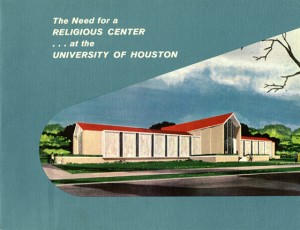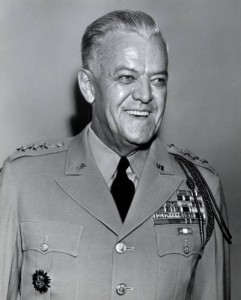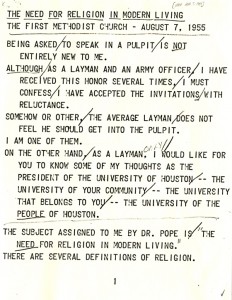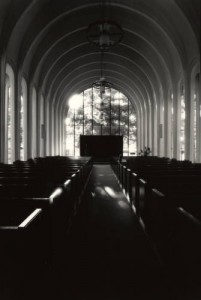

promotional material for the proposed Religion Center, from the UH Business Manager (McElhinney) Records
On a Sunday afternoon, forty-nine years ago today, the A.D. Bruce Religion Center (then the “University Religion Center”) was officially dedicated on the University of Houston campus.
Built out of University President A.D. Bruce’s desire to provide facilities for the growing and diverse religious communities on campus, the A.D. Bruce Religion Center offers a focal point for religion’s role in higher education, hosting programs and activities while placing an emphasis on dialogue between the faiths. The A.D. Bruce Religion Center is the permanent home to numerous campus ministries. Focal points include a stunning University Chapel (which serves as a popular site for weddings and other occasions befitting the grandeur afforded by the abundant use of glass in the design, creating a vision of towering walls open to the University campus), along with a smaller Meditation Chapel, and facilities and services find themselves in demand year-round from students, faculty, staff, alumni, and the community at large.

General Andrew Davis (A.D.) Bruce, from the UH Photographs Collection (1954)
A.D. Bruce, LTG (Ret.) arrived on campus in 1954, after a lengthy and successful career in military administration that included serving as First Governor of Hokkaido, Japan as his 77th Infantry Division occupied the island. He was named to succeed retiring University President, C.F. McElhinney. The story of a religion center on campus has a common thread shared with much of the University’s history–the unprecedented growth of the student body in the post-war years of the 1940s and 1950s, represented most visibly in the rapid and necessary establishment of housing that became known as the Veteran’s Village. With barrack-like quarters housing a population of veterans and their families on campus in the years following World War II, while that same population began establishing a growing and disparate number of student religious groups (unified in 1947 as the “Religious Groups Council”), a retired general like Bruce was struck by one glaring omission as he strolled across campus. How is it, he asked, that soldiers on an army base have access to a base chapel, but students living at the University of Houston do not?

first page of a speech delivered by Bruce to the First Methodist Church, from the UH Business Manager (McElhinney) Records (1955)
Thus, in 1956, as different groups began looking at the possibilities of housing their offices and activities off-campus, Bruce began meeting with the various stakeholders and attempted to create a coalition to support the establishment of an on-campus chapel complex to house the organizations. As Russell Vardell writes in his history of the Center, A Physical Symbol of the Religious Presence on the University of Houston-University Park Campus, 1965-1985, religious objections to a shared space of worship were overcome by a particularly military-like solution: “The General advanced the model of the Armed Forces Base Chapel. Various faiths shared the same worship space in military quarters because such a chapel was considered ‘neutral’ when not in use by a specific group.”
The rest, as they say, is history. There were plenty of speed bumps and even a few roadblocks along the way (issues of church-state separation became particularly thorny as the University sought to become a public institution), but a consensus was built among the Religious Groups Council, the Board of Regents tapped architect Frank Dill to begin work on the proposed building, funds were raised from various sources (including substantial contributions from the religious groups themselves), ground was broken, and construction culminated with the dedication of the University Religion Center on May 23, 1965. In attendance that Sunday afternoon were clergy, dignitaries, members of the community, and one former University President and Chancellor of note.

Interior, A.D. Bruce Religion Center, from the UH Photographs Collection
Retired from the University of Houston in 1961, A.D. Bruce would travel from his home in North Carolina to see a dream of his, born almost a decade prior, finally come to fruition.
General Bruce would pass away in 1969 and is buried in the Arlington National Cemetery. That year the Board of Regents voted to change the name of the University Religion Center, in honor of A.D. Bruce and his vision of the role religion could play in higher education.
Those interested in further details should be sure to read Vardell’s history of the A.D. Bruce Religion Center. Ready to dig deeper? Come see what new light the University Archives might shed on the subject!